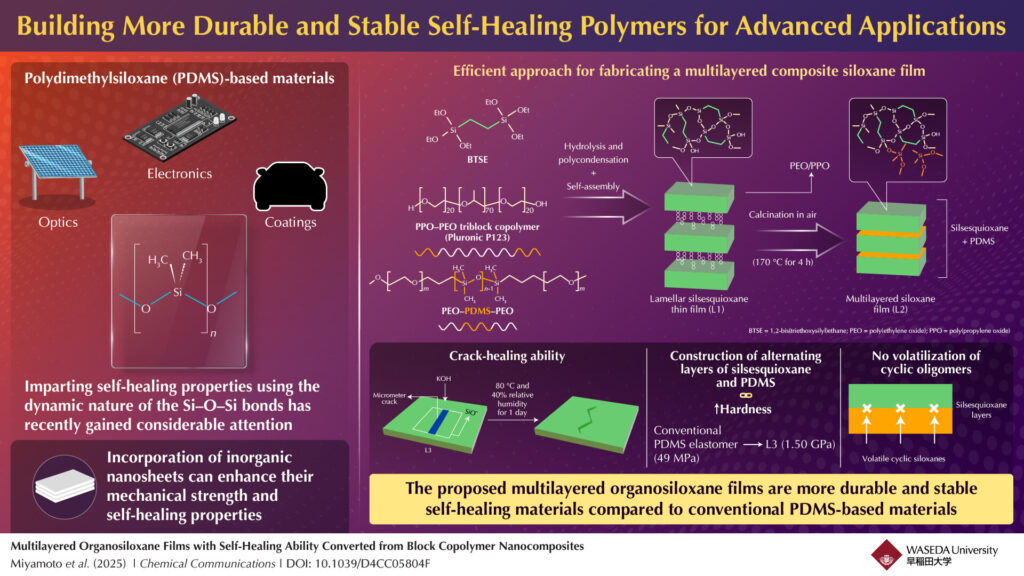Polysiloxane materials, such as polydimethylsiloxane (PDMS)-based elastomers, exhibit a self-healing capability by the introduction of silanolate (Si–O–) groups. This ability stems from their dynamic siloxane (Si–O–Si) bonds, which can break and reform to repair damage. Their self-healing properties could make them valuable in applications like protective coatings for use in various fields, such as optics, electronics, and aerospace.
To improve the properties of PDMS-based materials, they have been combined with inorganic fillers such as nanoparticles or nanosheets. Generally, the introduction of nanosheets into polymers leads to the formation of a layered structure that exhibits superior thermal, mechanical, and gas barrier properties. Furthermore, an improved crack-healing ability of oriented films has been reported. This improvement is attributed to polymer diffusion concentrated in the in-plane direction.
Researchers at Waseda University, Japan, have made significant progress in enhancing self-healing siloxane materials by developing a more efficient method for fabricating multilayered films. In a study published 6 January 2025, in the journal Chemical Communications, a team led by Professor Atsushi Shimojima, with Research Associate Yoshiaki Miyamoto and Assistant Professor Takamichi Matsuno, fabricated a composite film comprising highly cross-linked organosiloxane (silsesquioxane) and grafted PDMS layers using a self-assembly process.
“Replacing traditional materials with our self-healing material, which is less susceptible to deterioration and has high hardness, would be in high demand for maintenance-free and durable applications,” says Miyamoto, the lead author of the study.
The researchers began by depositing a solution containing 1,2-bis(triethoxysilyl)ethane, Pluronic P123 (a PEO–PPO–PEO triblock copolymer, where PEO stands for poly(ethylene oxide) and PPO stands for poly(propylene oxide)), and a PEO–PDMS–PEO block copolymer onto a silicon or glass substrate using spin-coating or drop-casting techniques. This process formed a thin film with a lamellar (layered) structure.
The film was then calcinated in air at 170 °C for 4 hours, resulting in the removal of the PEO and PPO blocks. This process left behind a multilayered structure composed of silsesquioxane and PDMS layers.
To impart self-healing properties to the film, Si–O– groups were introduced. These groups promote rearrangement and reconnection of the siloxane (Si–O–Si) networks. To achieve this, the film was immersed in a solution of tetrahydrofuran, water, and potassium hydroxide (KOH). In this process, hydroxide ions (OH–) from KOH removed protons (H+) from silanol (Si–OH) groups, converting them into Si–O– ions. The final film could repair micrometer-scale cracks when heated to 80 °C at 40% relative humidity for 24 hours.
The film showed superior properties compared to conventional PDMS-based materials. The cross-linked organosiloxane layers provided greater rigidity and served as a barrier against the volatilization of cyclic siloxanes, addressing the limitations of traditional PDMS materials. While conventional self-healing PDMS elastomers have a hardness of 49 MPa, the final self-healing film exhibited a hardness of 1.50 GPa.
“This innovative multilayered design allows our material to be both harder and more heat-resistant than existing self-healing siloxane-based materials, paving the way for more durable and reliable applications,” says Miyamoto.
With its high hardness and self-healing properties, this material is well-suited for protective coatings, flexible electronics, and other applications that require long-lasting performance.


